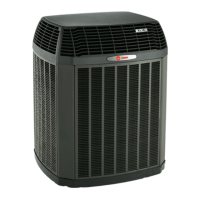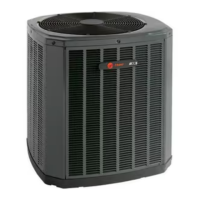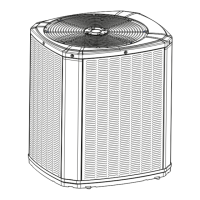Do you have a question about the Trane 4TTV0048A1000A and is the answer not in the manual?
Critical warnings about electrical hazards and safety procedures for outdoor units.
Safety precautions regarding refrigerant oil, its properties, and handling during service.
Alerts about hot surfaces on the outdoor unit to prevent burns during operation or service.
Guidelines for safe handling of refrigerant, including pressure and PVE oil.
Importance of proper grounding for electrical safety and equipment protection.
Safety advice for operating service valves to prevent abrupt refrigerant release.
Essential precautions for brazing refrigerant lines to prevent damage or injury.
Warnings about high leakage current and the necessity of earth connection.
Specific safety warning for 400V electrical hazards and required waiting periods before service.
Details on outdoor unit dimensions and estimated weight for installation planning.
Specifications for refrigerant line and service valve connection sizes for various models.
Alternative refrigerant line and service valve connection sizes for specific models.
Guidance on optimal outdoor unit placement for reliability and service access.
Precautions for installing units in areas prone to snow accumulation and freezing.
Requirements for coastal installations, including seacoast salt shields.
Criteria for selecting and preparing a suitable support pad for unit installation.
Determining required refrigerant line length and vertical change for charging calculations.
Importance and methods for insulating refrigerant lines for optimal performance.
Precautions and requirements when reusing existing refrigerant lines for retrofits.
Guidelines for routing refrigerant lines within structures to minimize noise and ensure proper installation.
Methods for isolating refrigerant lines from structural elements like joists and rafters.
Techniques for isolating refrigerant lines when run through wall spaces.
Procedures for isolating refrigerant lines passing through walls, ensuring proper sealing.
Step-by-step instructions for properly brazing refrigerant lines to service valves.
Continuation of brazing procedures, including wet rags and filter drier installation.
Steps for performing a leak check on refrigerant lines using nitrogen and soap solution.
Procedure for evacuating the refrigerant lines and indoor coil to a specific micron level.
Calculation method for determining refrigerant charge for heat pumps using weigh-in.
Calculation method for determining refrigerant charge for air conditioners using weigh-in.
Worksheet and steps for calculating refrigerant charge for new installations via weigh-in.
Worksheet and steps for calculating refrigerant charge for repairs via weigh-in.
Instructions for safely opening the gas service valve after system completion.
Instructions for safely opening the liquid service valve, emphasizing caution.
Maximum allowable lengths for low voltage control wiring based on wire size.
Diagrams illustrating low voltage wiring connections for communicating systems.
Guidelines for high voltage power supply, nameplate agreement, and code compliance.
Requirements for installing a separate disconnect switch for high voltage connections.
Procedures for grounding the outdoor unit for high voltage electrical safety.
Explanation of the status (green) LED indications for unit operation and modes.
Explanation of the communication (amber) LED indications for system status and errors.
Comprehensive steps required to safely start up the HVAC system after installation.
Outdoor and indoor temperature conditions required for accurate subcooling charge adjustment.
Template for calculating final subcooling value using line length, lift, and design subcooling.
Charts and tables to determine subcooling corrections and R-410A charging parameters.
Method for adjusting refrigerant level to achieve proper gage pressure using charging charts.
Waiting period required for the system to stabilize after adjustments for accurate readings.
Referencing system pressure curves to verify typical performance after charging.
Recording essential system pressures and temperatures after charging is complete.
Instructions on navigating the Communicating Display Assembly menus and screens.
Overview of the different technician menus available on the CDA for system configuration and testing.
Explanation of how demand defrost operates based on temperature sensors and delta-T.
How fault conditions related to defrost are indicated by the CDA.
Conditions required for the demand defrost system to become enabled.
The logic and criteria used to initiate the defrost cycle for the heat pump.
Steps to manually initiate and execute a forced defrost test via the CDA.
A comprehensive checklist of items to verify before finalizing system installation.
| Model | 4TTV0048A1000A |
|---|---|
| Type | Heat Pump |
| Cooling Capacity | 48000 BTU/H |
| Heating Capacity | 48000 BTU/H |
| SEER Rating | 16 |
| HSPF Rating | 9.0 |
| Refrigerant | R-410A |
| Voltage | 208/230V |
| Phase | 1 |
| Compressor Type | Scroll |












